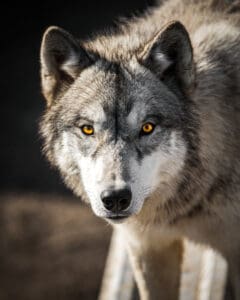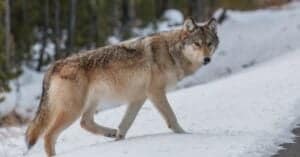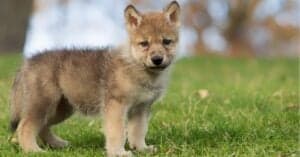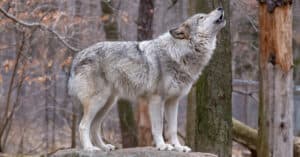Do Wolves Make Good Pets? Choose a Look-Alike Instead
@media (min-width: 481px) {
.mobile-top-content {
display: none;
}
}
#mobileTopContentCTACarouselControls { overflow: hidden; text-overflow: ellipsis; white-space: nowrap; }
.mobile-top-content .more { color: #fff; }
.mobile-top-content a { color: #fff; text-decoration: underline; }
.mobile-top-content a:hover { color: #fff; text-decoration: underline; }
@media (max-width: 480px) {
.mobile-top-content {
background-color: #06a10b;
color: #fff;
text-align: center;
/*height: 60px;
padding-top:5px;*/
font-size:80%;
/* display: block; */
margin: 0px -30px;
}
}
Do wolves make good pets for you and your family? The answer is that wolves do not make good pets, but a number of dog breeds that have traits similar to wolves could be what you’re looking for. However, the reasons why wolves should stay in the wild are pretty fascinating.
Keep reading to learn more about how wolves make problematic pets, the main differences between wolves and dogs, and whether hybrid wolves make good pets. We also list some domesticated dogs that look like wolves but make much better companions instead.
Do Wolves Make Good Pets?

Holly S Cannon/Shutterstock.com
Wolves don’t make good pets for more reasons than you might think. Wolves are not domesticated; they are athletic masters of escape, need constant supervision, and can become aggressive.
Unlike dogs, wolves aren’t bred to be domesticated. National Geographic defines domesticated animals as those bred for many years to become genetically adapted to living in harmony with people. A domesticated dog has different instincts and behaviors, making it better suited to humans.
Wolves kept in captivity often find ways to escape their homes and pens. Outdoor enclosures for wolves need to be incredibly sturdy and at least 8 feet high. Even then, a wolf may still find a way out. According to an article in the Des Moines Register, a family in Arizona learned this the hard way when their wolf pet, Lincoln, escaped his tall enclosure. Lincoln was soon found but escaped his temporary pen at a vet clinic and snuck out a window he unlatched.
Pet wolves are at least occasionally hostile to humans. For example, male wolves get aggressive with other males during mating season, including humans. And while a pet female wolf is in heat, aggressive male wolves could come to call.
Can Wolf Pups Be Domesticated?
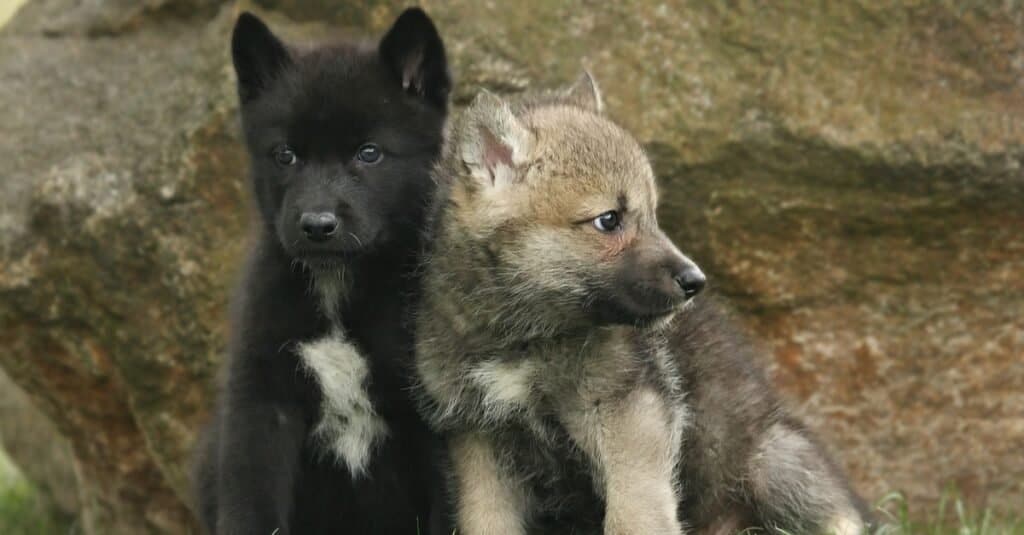
Jan Hejda/Shutterstock.com
No, wolf pups cannot be domesticated by simply raising them with humans. Even if you raise a baby wolf as a pet from the moment it’s born, its genetic makeup is still that of a wild animal. Eventually, the wolf puppy will develop behaviors that will make it challenging to raise.
If you decide to raise a baby wolf as a pet, commit to caring for the animal for its entire lifespan of up to 20 years because they will bond to you but not many other humans. The oldest wolf ever on record was a female in the UK named Madadh that lived to be 19 years old.
A study published in the Royal Society of Open Science determined that wolves raised as pets form an attachment to their human caregivers from a very young age. This bond lasts through adulthood, which means your pet wolf could have difficulty bonding with new people if it is rehomed.
So if you bring a wolf puppy home, know you’d be raising a wild animal with special needs. And study up on the wildlife laws in your area. For example, raising wolves as pets might be illegal where you live.
What’s the Difference Between Wolves and Dogs?
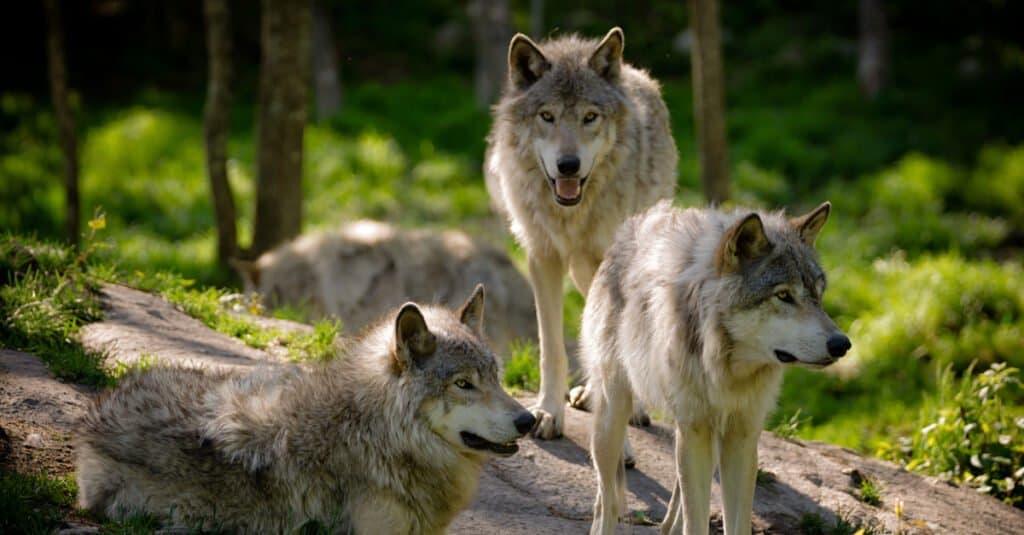
There are numerous differences between wolves and dogs. Here are some interesting differences to consider before thinking wolves make good pets.
- Wolves have larger heads than dogs, plus narrower bodies and longer legs. Their narrow build and long legs make wolves great runners for hunting prey.
- A wolf has two more toes on its front feet than dogs do, and the extra toes are webbed! Their webbed toes help wolves walk in snowy landscapes and swim across rivers.
- Wolf jaws are more substantial than a domesticated dog’s jaw because wolves need to catch and kill animals to eat.
- Different dog breeds can have different eye colors, but wolf eyes are always a shade of yellow or gold.
- Dogs are bred to bond and socialize with humans. However, a wolf’s instinct is to live independently of humans and not trust them.
- Baby wolves are usually born in spring, but dogs can have new litters of puppies at various times of the year.
- A dog’s instinct is to bark, whereas wolves more often howl.
- It’s easier for humans to feed a dog than a wolf because dogs thrive on various meats, vegetables, and grains. A wolf’s diet is very high in meat from big game and small animals. A wolf needs to eat at least four pounds of meat every day and eat up to 20 pack animals per year.
Do Hybrid Wolves Make Good Pets?
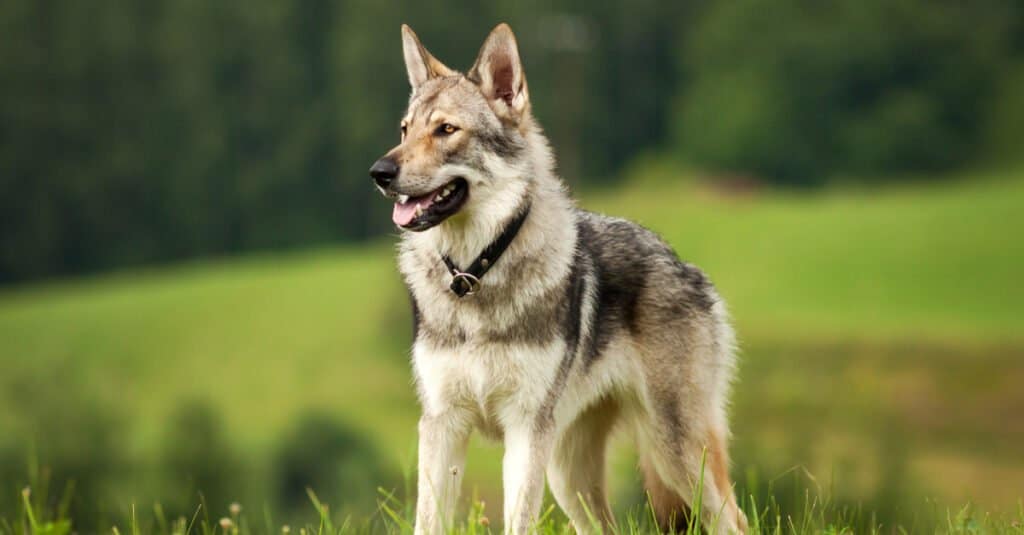
The wolf-dog or hybrid wolf is the mixed-breed offspring of a wolf and domestic dog. Unfortunately, a hybrid wolf is still a large animal with wild instincts that needs constant supervision. Like wolves, wolf dogs require pens with fencing at least 8 feet high. And forget about trying to board your wolf dog at a kennel. Their staff cannot care for high-energy and often aggressive hybrid wolves while you’re out of town.
The number of wolf dogs abandoned at shelters is growing. Unfortunately, most dog shelters cannot provide these animals with specialized care.
Though some people think it’s exciting to raise a hybrid wolf, the reality can be much more complicated than expected.
Which Dogs Look Like Wolves?
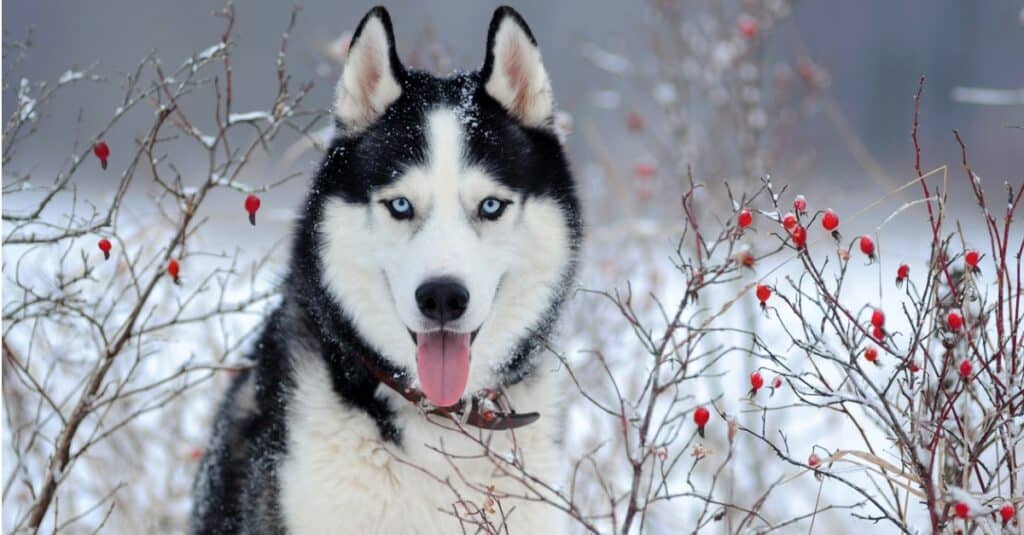
iStock.com/format35
Wolves don’t make good pets, but some dogs that do make great pets have similar physical traits. Choosing a wolf look-alike as a pet provides the appeal of wolf-like features without the headache of wild wolf habits.
Husky dogs are popular among pet owners who love the look of wolves. There are key differences between huskies and wolves that make huskies petter pets. For example, pet wolves resist obedience training but husky dogs are easily trained.
Here’s a list of domesticated dog breeds that have similar builds, beautiful shaggy coats, and other physical features like wolves:
- Alaskan Malamute
- American Alsatian
- Canadian Eskimo Dog
- Finnish Lapphund
- German Shepherd
- King Shepherd
- Kugsha/Ameridian Malamute
- Northern Inuit Dog
- Samoyed
- Shiloh Shepherd
- Siberian Husky
- Swedish Vallhund
- Tamaskan
The Kugsha breed has a controversial lineage because it may have originated as a wolf-dog mix. However, the Kugsha breed developed so many years ago it’s considered domesticated by now. Kugsha dogs are also known as Ameridian Malamutes or American Huskies, but this working-class breed with an undocumented past isn’t currently recognized by kennel clubs worldwide.
More from A-Z Animals
.more-snake-card-image { max-height:140px !important; }
@media (min-width: 481px) {
.mobile-top-content {
display: none;
}
}
#mobileTopContentCTACarouselControls { overflow: hidden; text-overflow: ellipsis; white-space: nowrap; }
.mobile-top-content .more { color: #fff; }
.mobile-top-content a { color: #fff; text-decoration: underline; }
.mobile-top-content a:hover { color: #fff; text-decoration: underline; }
@media (max-width: 480px) {
.mobile-top-content {
background-color: #06a10b;
color: #fff;
text-align: center;
/*height: 60px;
padding-top:5px;*/
font-size:80%;
/* display: block; */
margin: 0px -30px;
}
}
Do wolves make good pets for you and your family? The answer is that wolves do not make good pets, but a number of dog breeds that have traits similar to wolves could be what you’re looking for. However, the reasons why wolves should stay in the wild are pretty fascinating.
Keep reading to learn more about how wolves make problematic pets, the main differences between wolves and dogs, and whether hybrid wolves make good pets. We also list some domesticated dogs that look like wolves but make much better companions instead.
Do Wolves Make Good Pets?

Holly S Cannon/Shutterstock.com
Wolves don’t make good pets for more reasons than you might think. Wolves are not domesticated; they are athletic masters of escape, need constant supervision, and can become aggressive.
Unlike dogs, wolves aren’t bred to be domesticated. National Geographic defines domesticated animals as those bred for many years to become genetically adapted to living in harmony with people. A domesticated dog has different instincts and behaviors, making it better suited to humans.
Wolves kept in captivity often find ways to escape their homes and pens. Outdoor enclosures for wolves need to be incredibly sturdy and at least 8 feet high. Even then, a wolf may still find a way out. According to an article in the Des Moines Register, a family in Arizona learned this the hard way when their wolf pet, Lincoln, escaped his tall enclosure. Lincoln was soon found but escaped his temporary pen at a vet clinic and snuck out a window he unlatched.
Pet wolves are at least occasionally hostile to humans. For example, male wolves get aggressive with other males during mating season, including humans. And while a pet female wolf is in heat, aggressive male wolves could come to call.
Can Wolf Pups Be Domesticated?

Jan Hejda/Shutterstock.com
No, wolf pups cannot be domesticated by simply raising them with humans. Even if you raise a baby wolf as a pet from the moment it’s born, its genetic makeup is still that of a wild animal. Eventually, the wolf puppy will develop behaviors that will make it challenging to raise.
If you decide to raise a baby wolf as a pet, commit to caring for the animal for its entire lifespan of up to 20 years because they will bond to you but not many other humans. The oldest wolf ever on record was a female in the UK named Madadh that lived to be 19 years old.
A study published in the Royal Society of Open Science determined that wolves raised as pets form an attachment to their human caregivers from a very young age. This bond lasts through adulthood, which means your pet wolf could have difficulty bonding with new people if it is rehomed.
So if you bring a wolf puppy home, know you’d be raising a wild animal with special needs. And study up on the wildlife laws in your area. For example, raising wolves as pets might be illegal where you live.
What’s the Difference Between Wolves and Dogs?

There are numerous differences between wolves and dogs. Here are some interesting differences to consider before thinking wolves make good pets.
- Wolves have larger heads than dogs, plus narrower bodies and longer legs. Their narrow build and long legs make wolves great runners for hunting prey.
- A wolf has two more toes on its front feet than dogs do, and the extra toes are webbed! Their webbed toes help wolves walk in snowy landscapes and swim across rivers.
- Wolf jaws are more substantial than a domesticated dog’s jaw because wolves need to catch and kill animals to eat.
- Different dog breeds can have different eye colors, but wolf eyes are always a shade of yellow or gold.
- Dogs are bred to bond and socialize with humans. However, a wolf’s instinct is to live independently of humans and not trust them.
- Baby wolves are usually born in spring, but dogs can have new litters of puppies at various times of the year.
- A dog’s instinct is to bark, whereas wolves more often howl.
- It’s easier for humans to feed a dog than a wolf because dogs thrive on various meats, vegetables, and grains. A wolf’s diet is very high in meat from big game and small animals. A wolf needs to eat at least four pounds of meat every day and eat up to 20 pack animals per year.
Do Hybrid Wolves Make Good Pets?

The wolf-dog or hybrid wolf is the mixed-breed offspring of a wolf and domestic dog. Unfortunately, a hybrid wolf is still a large animal with wild instincts that needs constant supervision. Like wolves, wolf dogs require pens with fencing at least 8 feet high. And forget about trying to board your wolf dog at a kennel. Their staff cannot care for high-energy and often aggressive hybrid wolves while you’re out of town.
The number of wolf dogs abandoned at shelters is growing. Unfortunately, most dog shelters cannot provide these animals with specialized care.
Though some people think it’s exciting to raise a hybrid wolf, the reality can be much more complicated than expected.
Which Dogs Look Like Wolves?

iStock.com/format35
Wolves don’t make good pets, but some dogs that do make great pets have similar physical traits. Choosing a wolf look-alike as a pet provides the appeal of wolf-like features without the headache of wild wolf habits.
Husky dogs are popular among pet owners who love the look of wolves. There are key differences between huskies and wolves that make huskies petter pets. For example, pet wolves resist obedience training but husky dogs are easily trained.
Here’s a list of domesticated dog breeds that have similar builds, beautiful shaggy coats, and other physical features like wolves:
- Alaskan Malamute
- American Alsatian
- Canadian Eskimo Dog
- Finnish Lapphund
- German Shepherd
- King Shepherd
- Kugsha/Ameridian Malamute
- Northern Inuit Dog
- Samoyed
- Shiloh Shepherd
- Siberian Husky
- Swedish Vallhund
- Tamaskan
The Kugsha breed has a controversial lineage because it may have originated as a wolf-dog mix. However, the Kugsha breed developed so many years ago it’s considered domesticated by now. Kugsha dogs are also known as Ameridian Malamutes or American Huskies, but this working-class breed with an undocumented past isn’t currently recognized by kennel clubs worldwide.

